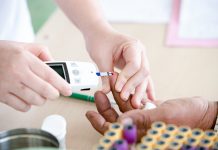Diabetes can pose significant implications for individuals’ mental and physical wellbeing. While new research shows promise in supporting diabetes management and care, many challenges still remain. We discussed these with Beyond Type 1’s content strategist Dr Liz Kopco
According to the Centers for Disease Control and Prevention (CDC), 37 million people in the U.S. have diabetes, roughly equating to one in every ten people. What’s more, one in five people do not know they have the condition.
The disease itself is categorised as type 1 (where the body does not make enough insulin) and type 2 (where the body is unable to use insulin correctly).
In recent years, the number of people diagnosed with type 2 diabetes has been increasing, and it now accounts for 90-95% of all diagnosed diabetes cases.
Young people, in particular, have shown a worrying susceptibility to diabetes, with the latest figures from the CDC revealing that between 2001 and 2017, those aged 20 or under living with type 1 diabetes increased by 45%, and the number living with type 2 diabetes grew by 95%.
This upwards trend could mean as many as 220,000 young people will or may have type 2 diabetes in 2060 — a nearly 700% increase. (1)
Not only is diabetes becoming increasingly costly for health systems, it can heavily impact a person’s physical and mental wellbeing and increase their susceptibility to serious health complications, including kidney failure, heart disease and loss of limbs.
Hoping to raise awareness and improve care for those living with diabetes through peer support programs, global campaigns and digital platforms is a nonprofit organisation called Beyond Type 1, which serves both type 1 and type 2 diabetes communities.
Lorna Rothery spoke to Beyond Type 1’s content strategist Dr Liz Kopco about the challenges facing patients and the measures needed to improve diabetes management and care.
Type 2 diabetes in young people
Why has type 2 diabetes increased among young people during the last 20 years?
Several factors increase a young person’s risk of developing type 2 diabetes (T2D). These include genetics and family history, the mother having gestational diabetes during pregnancy, having other conditions that impact insulin resistance, hormones during puberty and being from a background that is predisposed to having fewer resources available like African American, Hispanic/Latino, Native American/Alaska Native, Asian American, or Pacific Islander.
Studies like the Treatment Options for Type 2 Diabetes in Adolescents and Youth (TODAY) and SEARCH for Diabetes in Youth have found that young people who develop T2D at an early age are also more likely to experience complications from it—even in their early 20s.
Unfortunately, these studies also showed that socioeconomic status is a significant factor putting young people from underserved communities at risk for T2D. Disparities like food insecurity, lack of safe environments for daily movement, income levels and lack of access to affordable healthcare are common risk factors.
The COVID-19 pandemic added to the vast disparities. Younger people from low-income communities, who tend to make up more of the workforce and not deemed essential workers, were laid off and left without income or health insurance.
In addition, the overwhelming stress from the pandemic may have contributed to increased prevalence since stress can impact blood sugar regulation.
Newer studies are also finding that individuals with prior infections of COVID-19 have a higher risk of developing diabetes.
With research showing that T2D is developing in younger people, providers may be screening for it at younger ages, leading to an increase in diagnoses. Getting an early diagnosis is critical to helping establish diabetes management early and prevent or delay the onset of complications.
However, we cannot stop at diagnosis. As someone diagnosed with type 2 diabetes at 23, I know there is a considerable lack of support for younger people with diabetes because of the assumption that younger people are supposed to be healthier and therefore do not need preventative care.
When most of the resources on T2D depict and target people in their 50s or older, it is a disservice to these younger people. Trying to navigate life at 23 was difficult enough; managing a chronic disease was not a top priority, given that I barely had any health insurance in college.
Thankfully, Beyond Type 2 had resources all in one place for those newly diagnosed and even for navigating insurance.
We need to ensure diabetes education for newly diagnosed younger people is tailored to their lifestyle and is geared toward their interests—partying with diabetes, managing diabetes during puberty, etc.
COVID-19 and diabetes
How did the COVID-19 pandemic highlight the importance of addressing chronic diseases like diabetes?
The COVID-19 pandemic opened everyone’s eyes to how vital our health is, especially with regards to prevention. For people with chronic illnesses like diabetes, the pandemic highlighted how complicated these interactions between viral infections and diseases are.
Having diabetes is a vital risk factor for developing adverse effects from COVID-19, and with approximately 37 million people in the U.S. having diabetes and an estimated eight million living with undiagnosed diabetes, this pandemic addressed how important it is to get everyone screened and diagnosed.
Even three years later, the International Diabetes Federation (IDF) reported on studies showing that adults with diabetes with elevated HbA1C levels have a 35-40% higher odds of COVID-19 hospitalisation and severe illness.
The key to preventing adverse outcomes with COVID-19 is better diabetes management, but during the pandemic, many people with diabetes were left to manage it on their own—some for the first time.
Imagine being newly diagnosed with diabetes right before everything shut down. People were left waiting months to be seen by providers to establish their diabetes management plan.
Thankfully telehealth became an option, but the pandemic showed how important teaching self-management of chronic diseases is. Providing people with the tools and knowledge they need for self-management is more important than ever.
Managing and preventing chronic diseases
Why is it essential to continue managing and preventing chronic diseases, now and in the future?
There are several reasons why preventing and managing chronic disease is important now and in the future. We all want a good quality of life. Preventing or managing chronic disease is critical for reducing complications which can negatively impact the quality of life.
Living with a chronic disease can also heavily impact mental health, and there is insufficient support for the intersect of mental health and chronic disease management.
Beyond Type 1 is a great resource that medical professionals can share with their patients. We have created various mental health resources to help address the gap in that education and support.
Given that healthcare affordability and accessibility challenges persist for some people, preventing chronic disease is important for people’s livelihood. No one should have to pick between managing their chronic condition or putting food on the table. Preventing chronic disease is also preventing further health disparities.
Even looking at the bigger impact, a recent study funded by the National Institute on Minority Health and Health Disparities estimated that the cost of racial and ethnic health disparities on the U.S. economy increased over a span of four years by 41% to $451 billion in 2018.
I would imagine that has only increased with the COVID-19 pandemic. The cost of chronic disease management is hurting the people directly impacted by it and the economy for several reasons, including the unregulated costs associated with healthcare.
Ignoring the cost of it, managing chronic disease is a human right—everyone’s right to live a healthy and fulfilling life is essential.
Type 2 diabetes prevention programmes
How effective are programmes and campaigns, such as those implemented by the CDC, in helping to prevent type 2 diabetes and increase understanding of the condition?
The CDC and National diabetes prevention programmes (DPP) are part of the solution needed to raise awareness, get people screened and diagnosed, provide the resources for self-management and the support people need. These are evidence-based programmes using data about diabetes management plans to help prevent, delay onset, or better manage life with type 2 diabetes.
The great thing is that DPPs are offered in various places—including local YMCAs and even online. Programmes and campaigns are only effective if they are
accessible to those needing them. Programmes in different languages, at local community centers and online improves prevention and management.
As far as understanding the condition, I think we still have a way to go for two reasons. First, it is difficult to make people look past established misconceptions and stigmas to educate them on the condition. When society and media perpetuate these misconceptions and stigmas, it is working against all the work these programmes and campaigns are trying to do.
Secondly, science must truly understand the condition because it is extremely complicated. There is no one cause for diabetes, which makes it hard to provide one treatment or cure.
What we do understand is that living with diabetes is very challenging physically and mentally. We all still need to raise awareness and provide support to prevent and manage type 2 diabetes.
What are researchers doing to find ways to prevent type 1 and type 2 diabetes?
A lot of amazing research is being done for both type 1 and type 2 diabetes. Every year researchers present their work and findings at conferences like the American Diabetes Association’s Scientific sessions and the International Conference on Advanced Technologies and Treatments of Diabetes (ATTD), to name a few. Beyond Type 1 will be highlighting and sharing some of the research at this year’s ADA conference.
As for type 1 diabetes, the current research is looking into several things like beta cell and gene therapy to help prevent further beta cell deterioration and even protect against type 1 diabetes development.
A recent beta cell summit hosted by three organisations, including JDRF, highlighted some pretty spectacular research being done that showed promising results on regenerating beta cell mass and more.
A big recent advancement was the FDA approval of Prevention Bio’s drug, Tzield (teplizumab-mzwv), to delay the onset of type 1 diabetes. This is the first drug of its kind, and I am excited to see how this paves the way for more treatments to come.
Type 2 diabetes research has also come a long way. Most studies in adults have focused on and concluded that lifestyle changes have a big impact on lowering risks, but recent studies have shifted and focused on the genetics behind type 2 instead.
A recent promising study utilised gene therapy to treat and even prevent the progress of type 2 diabetes.
The research is really breaking through barriers to go even beyond what past studies have done for preventing and treating all forms of diabetes. It is an exciting time for diabetes research and tech development.
References
Contributor Details
Editor's Recommended Articles
-
Must Read >> Understanding diabetes: Reducing the risk of type 2











